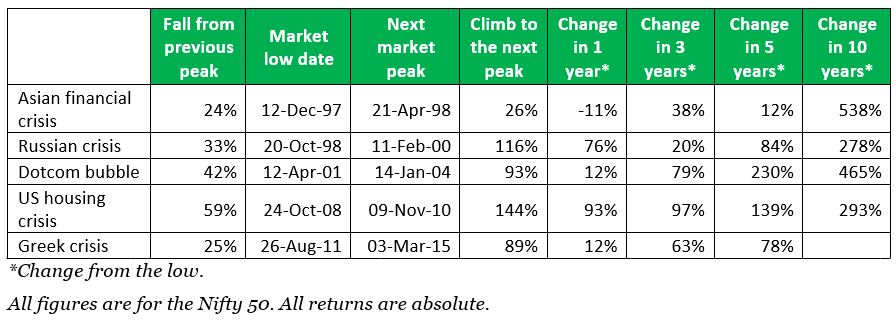There are concerns all round – climbing crude oil prices, depreciating domestic currency, escalating trade wars that are already beginning to bite, warnings over slower global economies and US corporate earnings. Markets are up one day, down the next.
The good news is that there is a lot of money to be made after a crisis. This isn’t new news by any means. But if you understood the nature of the recovery, you will know that there is wealth to be built only when there are crises.
The falls and the rises
The table below shows the past crashes in the Nifty 50 and the subsequent recoveries.

In this ongoing correction, we do not know where or when the bottom will be. So far, from the January 2018 high, the Nifty 50 is down 14.6% from its January peak. Since 2011, we have not had a steep correction like the one we are in currently. The taper tantrum of 2013 did see markets largely flat or briefly falling, but markets bottomed out in August 2013. Since then, there has been only a rally. The slides in 2015 (China growth concerns) and 2016 (demonetisation) were short-lived and barely count as a corrective or bear market phase. We are only now seeing a broad-based correction.
It is important to remember that steeper falls take more time to recover and that’s the precise reason to have a long-term view. As you can see, in the aftermath of each of the crises, the journey to the next peak has seen the money doubling in many instances. These returns have come within the next three years. The exception here is after 2001, where, owing to brief corrections in 2004 and 2006, the next actual peak was in 2008. This long bull run yielded 514% (money multiplying over 6 times).
The time you spend in the market also makes a difference. For example, anyone who had invested right after the Russian crisis would have more than trebled their money in the succeeding ten years. Yes, you would have invested at a low, but remember that this return is despite the market having contracted by 60% in 2008 after the US housing mortgage bubble burst. Hence it is only a question of patience. We’ve also written several times on the need to be long-term in equities – here’s one such article.
Buying opportunities
Yes, some crises have had a deep impact on our economy as well. But then, in such depressed state lies in buying opportunities. Our economy has weathered crises and emerged back onto the growth path, reflecting in stock markets as well. Slowdowns and corrections are par for the course. We also need volatility and corrections to bring markets back into rational zones; the unbroken run from 2014 needed a breather as stocks were climbing far ahead of their earnings capacity.
If you are among those sitting on the sidelines when markets fall, do note that there is no better opportunity than during falls. But it is hard to time such falls. Hence, the best you can do is to invest through SIPs or invest lump sums in a phased manner during such falls.
At the very least, the last thing you should do is to sell what you have already invested. Exiting now, especially if you have started investing in the past few years would be tantamount to selling at lows having bought at highs.







